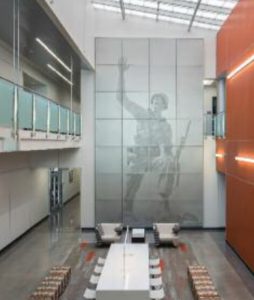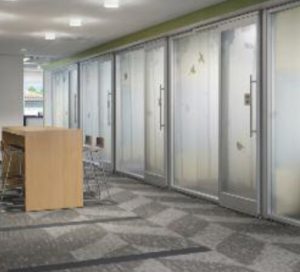Fall 2016
By K.J. Quinn
An unlikely source is emerging as a trendsetter for work- place design. With building interiors long considered ugly ducklings for their mundane looks, one of the nation’s largest commercial real estate owners is raising the bar for requirements in performance standards and style.

“GSA has really been a leader in new workplace design, from the standpoint that we were among the first people to say the way to do the best workplace design is understanding the workspace around it,’” said Kevin Kampschroer, chief sustainability officer at the U.S. General Services Administration (GSA). “The real strong value to government and any organization is to have people work together from time to time; that’s how you build cohesion. So the workplace isn’t looking for the same type of utilitarian needs as 40 years ago.” The agency manages architects and engineers to provide design for federal clients needing new workspaces.
The federal government is reportedly creating 21st century style workplaces to drive down cost, increase productivity and green office space. Within the past two years, GSA revised its facility standards and set requirements for new or renovated buildings, moving to a performance-based approach. The end result is federal projects are breaking away from institutional-type looks and creating workspaces which more closely resemble corporate offices.
“What we now see in facility standards are 16 types of flooring listed with levels of performance from minimum ‘scrape by’ to as good as you can get, measured on scales of durability, maintainability and environmental characteristics,” Kampschroer said. “We publish a set of performance standards to give the design team options, and really reinforce the idea we are not actually looking for particular products or solutions but the kinds of performance measured on those scales.”
This represents a radical change in philosophy for a sector that has historically specified based on price and functionality rather than floor design. The Design Excellence Program — operated through GSA’s Public Buildings Service — stresses creativity and streamlines the way GSA hires architects and engineers, substantially cutting the cost of competing for GSA design con- tracts. “The whole idea behind Design Excellence is the Federal government should not go the cheapest route possible,” Kampschroer explained. “There is value in design.”
The Federal government reportedly owns and leases nearly 10,000 properties, although only a percentage of them under go remodeling or new construction work during the year. While these projects are not necessarily increasing budgets to accommodate more expensive interior decorating products, designers are making smarter choices. For example, “We are building LEED Silver and Gold buildings at the exact same price as the buildings before,” Kampschroer said. “This was the result of [allowing] design teams to use their creativity and imagination, and for GSA project teams to be open minded to new solutions.” LEED-certified Federal buildings include approximately 130 owned by GSA and another 400 leased facilities.

One key factor driving change is lead time from when new construction or renovation projects appear on the books until they are shovel ready. In the past it was not uncommon for years to go by before the work was started, so interior design plans became antiquated. “We have told design teams, ‘If you can do a better design that achieves a higher level of performance, sustainability and show ideas, we will look at it with an open mind,’” Kampschroer said.
GSA has led the workplace transformation by renovating its own headquarters in Washington, D.C. Workspaces utilize multi- ple soft and hard surfaces which meet performance, sustainability and aesthetic objectives. “When you walk around our new headquarters, I can show you dozens of ideas that 20 years ago would not have occurred to people, even after Design Excellence, or 10 years ago after adopting sustainability into building design,” Kampschroer said.
EMPHASIS ON SUSTAINABILITY
There are a myriad of laws and regulatory acts at the federal level that require sustainable design in commercial applications. One of the most significant changes in floor covering for GSA projects is the advent of environmental standards. The objectives defined in Executive Order 13693 from last year require reductions in greenhouse gas emissions, waste and in water use.
“The objectives also require the use of recycled materials and efforts to recycle materials, as well as enhanced indoor environmental quality,” said Scott Landa, a consultant and former VP of business development for Interface. “Additionally, GSA’s Public Building Service, in its architectural guide document (P-100), has defined performance and environmental standards for all flooring used in buildings under GSA control.”
The standards have reportedly contributed to changes in materials used to produce soft surfaces such as carpet tile. “These standards require that companies provide a selection of its modular products that offer high recycled content levels — both postindustrial and post-consumer — as well as high performing carpet tile,” Landa said. “GSA measures performance through extended warranties, requirements for heavy and severe traffic wear, and ANSI NSF140 Gold and Platinum environmental standards.”
Concerns over meeting sustainability objectives have been greatly reduced, however, as more flooring manufacturers list environmental and health data for their products. “There’s a broad enough selection of products out there that meet sustain- ability requirements,” noted Peter Lepage, vice president, government sales division, CCA Government Floors & Interiors, Alexandria, Va.
Generally speaking, flooring specifications must adhere to all environmental, health and safety requirements of the Federal government. While functionality and sustainability are always high priorities, government specifiers are now focused more on the value of the products they select and less on price points. “Cost is always a consideration but not the driver in all cases,” Lepage said. “A lot of times the drivers could be the performance and design requirements for the facility.”
Shaw Contract Group’s broadloom, carpet tile and hard surface options are rigorously tested to ensure they suit the needs of any Federal government project, according to John Stephens, vice president of marketing. “These products are designed knowing it’s not always about the initial cost, but how a product performs over time in the facility.”
NEW FLOORING CHOICES MEET CHANGING WORKPLACE NEEDS

Flooring manufacturers say they are becoming more innovative in developing solutions for the government sector. More options are popping up, including products made from recycled materials and bio-based content that are low emitting or emissions- free. “The intent of the President’s executive order is to create environments that will first be places where employees can work efficiently and effectively in spaces that do not negatively impact our environment while also eliminating any indoor negative impact from unwanted volatile organic compounds (VOCs),” Landa said. “Soft surfaces provide the greatest coverage area in offices and, therefore, can be looked at to be a major contributor to solving problems.”
Case in point: New soft surfaces which exceed the GSA stain requirement are fiber-based products featuring inherent stain resistance — such as Solution Q Extreme fiber — while maintain- ing the texture requirements. “In addition to this high-performance option, innovations in primary backing, tufting and secondary backing have allowed soft surface manufacturers the ability to produce high-quality and high-performing products with less fiber,” noted Kieren Corcoran, marketing director, education and government, Patcraft.
The plethora of new commercial floors provides government specifiers with features to weigh and benefits to compare. “Carpet tile is a popular choice for several reasons,” Shaw’s Stephens said, “primarily because the cost of carpet tile has equalized with that of broadloom. Installation is quicker, easier and less costly.”
Government facility managers prefer a more conservative aesthetic and highly durable products due to the long life required, Corcoran pointed out. “In the areas where an open- office format is not possible, facilities are leveraging carpet tile design elements to cost effectively update their appearance.”
While high fashion flooring may appear more expensive on the surface, in many cases, the total cost of ownership is lower than traditional products. For example, industry studies indicate performance-wise, luxury vinyl tile (LVT) can be as cost effective if not more so, given it will have a payback period of about three years compared to floors maintained with wax or polish. “LVT offers higher aesthetic and better sustainability attributes than VCT,” Shaw’s Stephens said. “There’s also less maintenance with LVT, the aesthetic reads less institutional, and the performance and design features create an atmosphere conducive to attract and retain talent.”
As government agencies strive to be good stewards of the public’s dollars, this can provide impactful savings. “For example, if there is a problem that cannot be resolved, one carpet tile can be replaced via a cost-effective, efficient shuffle strategy rather than cutting out and replacing a piece of broadloom, potentially creating a visual eyesore or larger replacement expense,” Patcraft’s Corcoran said.
Indeed, there is a shift from broadloom carpet and VCT to LVT, especially in elevator lobbies, cafes and kitchens, as these facilities strive to establish a more inviting floor design — such as wood or stone visuals — instead of the traditional institutional feel. This design flexibility coupled with enhanced performance of the product provides excellent value to facility owners. “We’re finding that as every year goes by, we can do more with the same amount of investment,” GSA’s Kampschroer said. “As sustainability standards have gone up, manufacturers and the design and construction industry have responded with more creative ways of achieving performance goals without costing much money.”